About Depression
What is Depression?

Clinical depression (also referred to as major depression or major depressive disorder) is a serious condition that affects millions of Americans every year. It is significantly different from the periods of sadness or feelings of grief that occur as an expected part of life for most people. Although it is normal to be sad or “down” occasionally and to experience grief after a significant loss, clinical depression has more severe symptoms that often last for an extended period of time, and it is more likely to have an impact on a person’s ability to function normally.
Depression overview handout (PDF)
Common Symptoms of a Major Depressive Episode
A formal diagnosis of major depression may be made when a person has five or more of the following symptoms every day or almost every day during a two-week period, and at least one of the symptoms is depressed or irritable mood or loss of interest or pleasure in activities previously enjoyed.
- Depressed mood with overwhelming feelings of sadness and grief; and/or irritable mood
- Loss of interest and pleasure in activities formerly enjoyed
- Noticeable changes in appetite and weight
- Insomnia, early morning waking or oversleeping
- Restlessness or being physically slowed down
- Decreased energy or fatigue
- Feelings of worthlessness, guilt or helplessness
- Difficulty concentrating or thinking; indecisiveness
- Recurrent thoughts of death or suicide
Depression is the major risk factor for suicide.
Depression Recovery: A Pastor’s Personal Battle
The Rev. Pamula Yerby-Hammack, Executive Pastor at the City of Abraham Church & Ministries, discusses her experience with depression, the professional care she received, and the important role of family members and friends.
Depressive episodes can also be parts of other mood disorders, including bipolar disorder.
Bipolar I disorder consists of manic episodes that last at least seven days or manic symptoms that are so severe that the person needs immediate hospital care. Usually, depressive episodes occur as well, typically lasting at least two weeks. Episodes of depression with mixed features (depressive symptoms and manic symptoms at the same time) are also possible.
Bipolar II disorder is defined by a pattern of depressive episodes and hypomanic episodes, but not the extreme manic episodes that are typical of bipolar I disorder.
Living with Extreme Highs and Lows of Bipolar II Disorder
Latesha Higgs, a long-time volunteer with the National Alliance on Mental Illness and a tireless advocate for those with mental health conditions, shares her experiences living with the extreme highs and lows of her bipolar disorder.
Living with Bipolar Disorder
Amey Upton, M.Div., former director of adult education at Westminster Presbyterian Church in Alexandria, Virginia, shares her experience living with bipolar disorder and offers suggestions for how faith communities can address the needs of those with mental health conditions.
Warning Signs of Suicide
Suicide always needs to be a concern when talking with someone who is seriously depressed. It’s important to be able to recognize the warning signs and respond appropriately. The National Institute of Mental Health lists the following as signs that someone may be thinking about suicide:
- Talking about wanting to die or wanting to kill themself
- Talking about feeling empty, hopeless or having no reason to live
- Planning or looking for a way to kill themself, such as searching online, stockpiling pills or acquiring potentially lethal items (e.g., firearms, ropes)
- Talking about great guilt or shame
- Talking about feeling trapped or that there are no solutions
- Feeling unbearable pain--physical and/or mental
- Talking about being a burden to others
- Using alcohol or drugs more often
- Acting anxious or agitated
- Withdrawing from family members and friends
- Changing eating and/or sleeping habits
- Rage or talking about seeking revenge
- Taking risks that could lead to death, such as reckless driving
- Talking or thinking about death often
- Displaying extreme mood swings, suddenly changing from very sad to very calm or happy
- Giving away important possessions
- Saying goodbye to friends and family members
- Putting affairs in order, making a will
Warning signs of suicide handout (PDF)
If you or someone you know is in distress and needs immediate help, dial 988 for the National Suicide & Crisis Lifeline.
Suicide Risks
Studies have found that more than 90% of people who die by suicide have a mental health condition. In addition to depression, the National Institute of Mental Health lists other factors that may place a person at risk of suicide, including:
- Substance use disorder
- Chronic pain
- A history of suicide attempts
- Family history of a mental disorder or substance use
- Family history of suicide
- Exposure to family violence, including physical or sexual abuse
- Presence of guns or other firearms in the home
- Having recently been released from prison or jail
- Exposure, either directly or indirectly, to others’ suicidal behavior, such as that of family members, peers or celebrities


